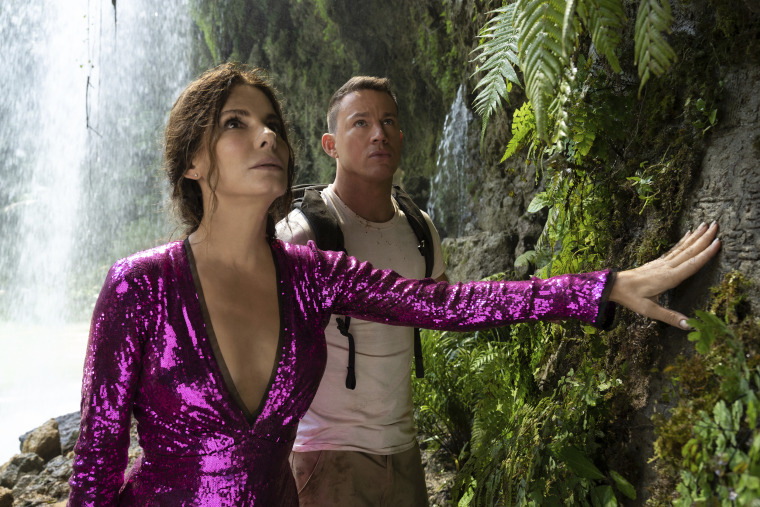In Hollywood, one shorthand for romance and empowerment is “colonialism.” Showrunners and directors have long shipped their characters off to exotic locales to highlight their special abilities or personal growth. From Iron Fist, Dr. Strange and Batman going East for mystical martial arts powers to James Bond seducing and assassinating his way across former British holdings to Harley Quinn beating the tar out of rooms full of burly nonwhite people, the non-Western world has long been a prop for tales of white self-empowerment.
Even movies that recognize the problems of colonial narratives can’t always figure out how to empower their (white) characters without it.
Adam and Aaron Nee’s new adventure rom-com “The Lost City” doesn’t exactly defy those tropes, but it does try to soften and deflate them. That makes it a more thoughtful and affecting film. But it also underlines how even movies that recognize the problems of colonial narratives can’t always figure out how to empower their (white) characters without it.
The film stars bestselling romance author Loretta Sage (played by Sandra Bullock). Five years ago, Loretta lost her archaeologist husband, and she is still struggling with her grief. She has finally finished a new romance novel about a remote Amazonian people she and her husband researched in real life.
Enter billionaire weirdo Abigail Fairfax (Daniel Radcliffe), who believes Loretta can help him translate clues to an ancient treasure. When she refuses, he kidnaps her. Her cover model Alan Caprison (Channing Tatum) hires a rugged adventurer Jack Trainer (Brad Pitt) to rescue Loretta — and then tags along because he’s got a crush on her.
The setup recalls the classic 1980s rom-com “Romancing the Stone,” up to and including the parallel steamy dance scene. But it doesn’t quite have the pizazz of the prototype: Tatum’s OK as a bumbling, eager himbo, but he can’t match Michael Douglas’ crotchety charisma. Bullock holds up her end, though, limping through the jungle in high heels, a purple jumpsuit and a load of exasperated weariness — all of which she sets aside with startled aplomb when she’s suddenly face-to-bits with Alan’s leech-covered nether regions.
As in “Romancing the Stone,” the joke is that the protagonist’s fictional novels are coming true. Loretta wrote a bunch of frankly silly stories channeling “Raiders of the Lost Ark” — and Alan dressed up as the main, shirtless character. Now, suddenly, they’re living the story: climbing cliffs, building fires and dodging bad men. Loretta and Alan just need to get out of the States, and they can be different, bigger people, in a more exciting landscape. That colonial fantasy is mostly true: The world is there for you, if you’re the white citizen of a superpower; you just need to go out and inhabit it.
Generally, white people seek not just power abroad, but treasure. “The Lost City,” though, is careful to condemn colonial greed. Fairfax wants to find money and prestige abroad, but he’s the bad guy. Loretta is motivated more by her sentimental connection to archaeological research; this journey is a tribute to her husband. And Alan just wants to make Loretta happy. (This latter dynamic allows Bullock to continue her streak of movies in which significantly younger men are completely dazzled by her, flipping Hollywood’s usual gendered script.)
Generally, white people seek not just power abroad, but treasure. “The Lost City,” though, is careful to condemn colonial greed.
“The Lost City” also goes out of its way to make sure the viewer knows that Loretta and Alan are fighting and dispatching mercenaries, not islanders. And the film’s conclusion does not tie true happiness to vast purloined wealth (as is the case in “Romancing the Stone”). Instead, the film ultimately is about how grief is a universally understood experience. The emotional payload is connection, not appropriation.
Nonetheless, the vestiges of appropriation are hard to get rid of. The main local character Rafi (played by Héctor Aníbal) gets his own mini-arc, but the story isn’t about him. His country and his heritage still mostly serve as a setting for some white Americans’ growth, excitement, danger and sexy flirtation.
None of this is to say the movie is bad. If, like me, you appreciate this genre, the movie is pretty good. It’s a well-written, frothy comedy, with attractive leads, a witty script and an earned, genuinely thoughtful twist at the end.
Yet, the appeal of “The Lost City” can’t be separated from colonial genre expectations. Loretta and Alan are bumbling and endearing, and you want them to own the landscape of their own lives. But Hollywood can seemingly only imagine them doing that in a setting where they implicitly own other people’s landscapes, too.

